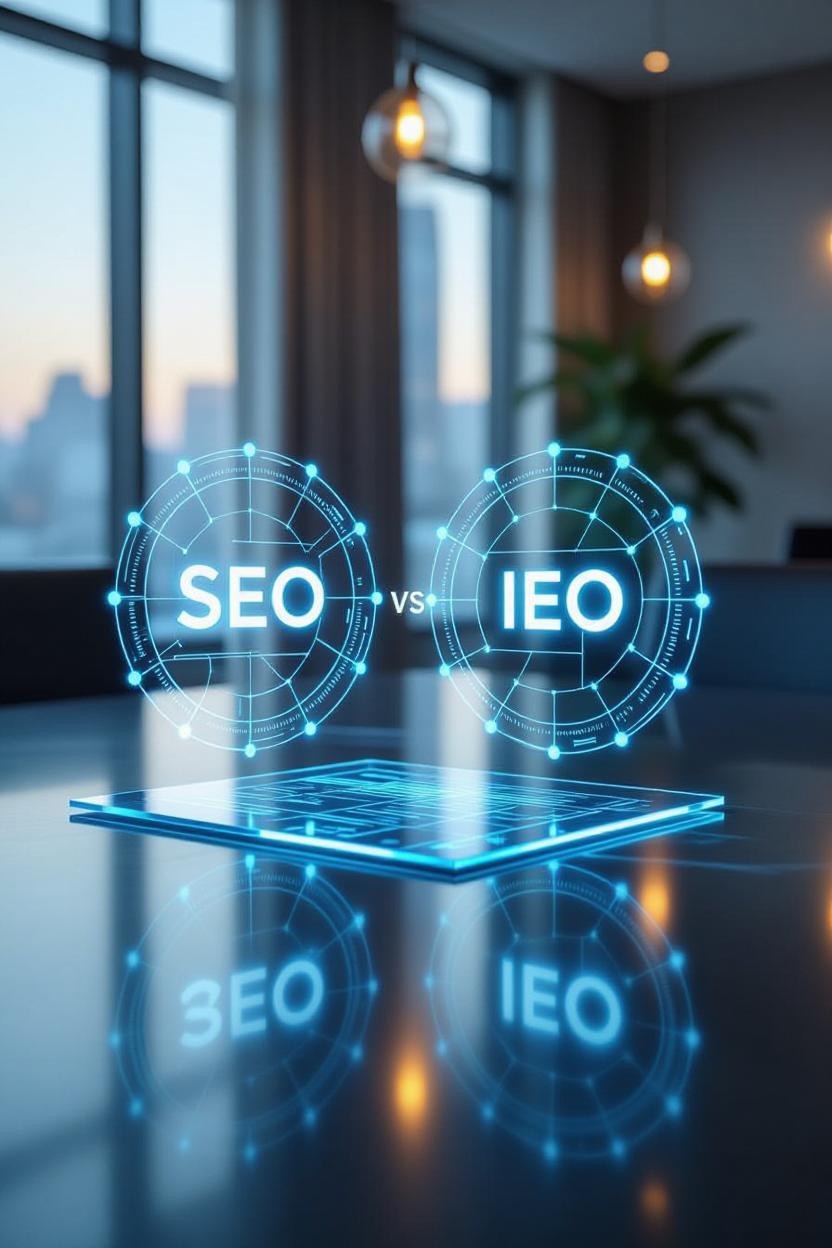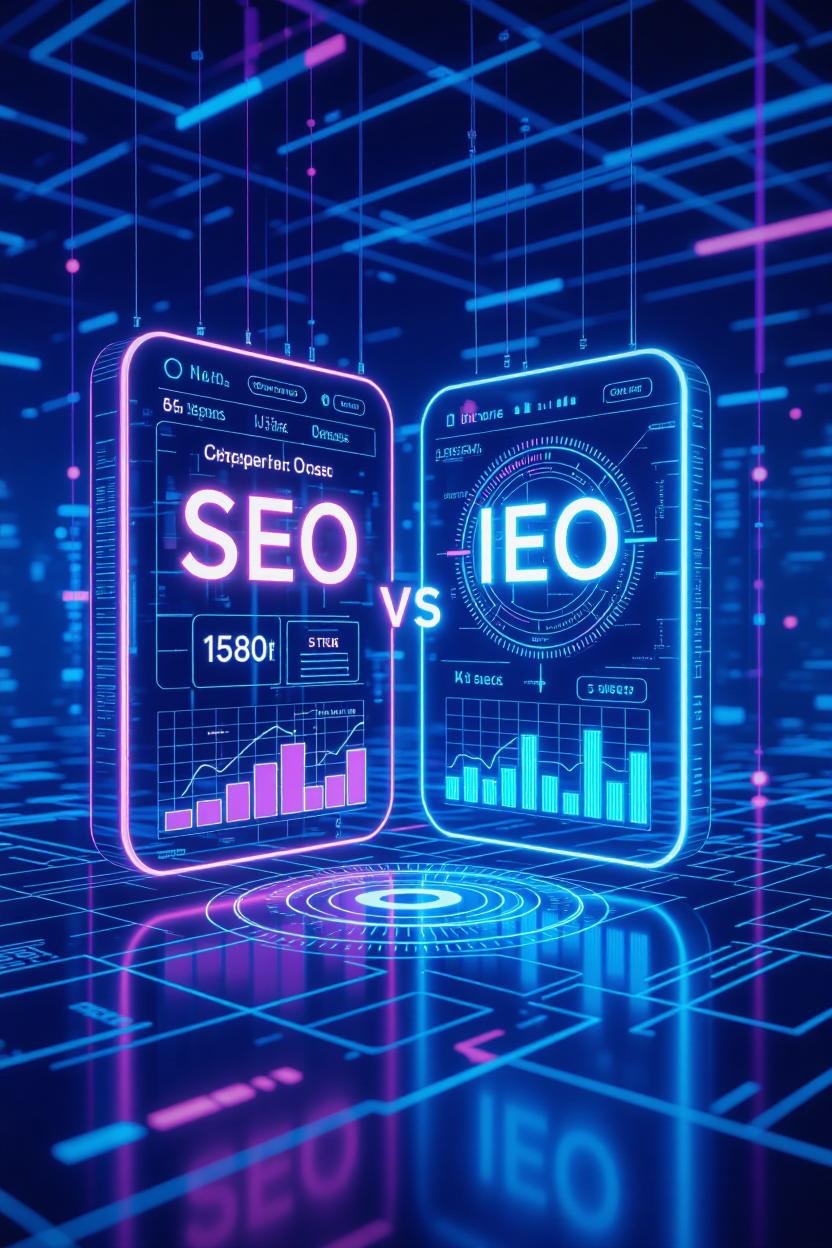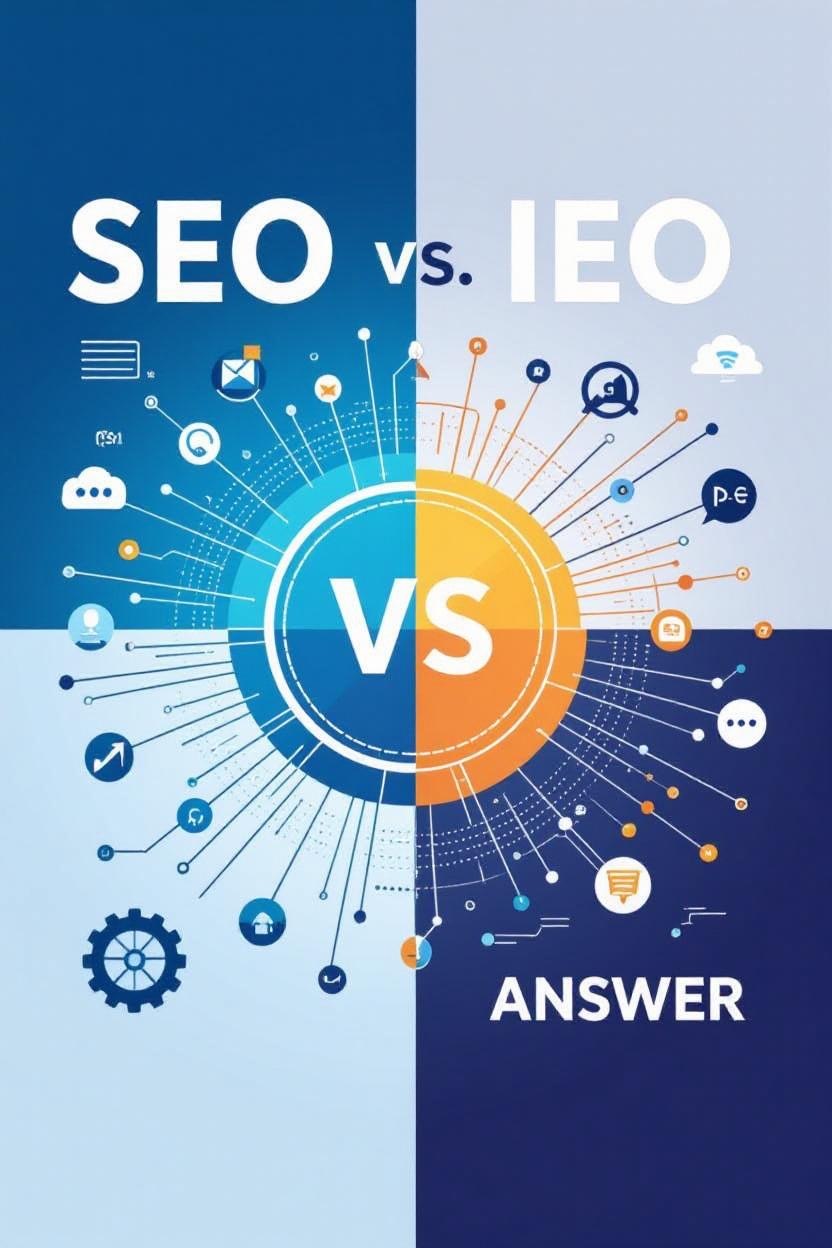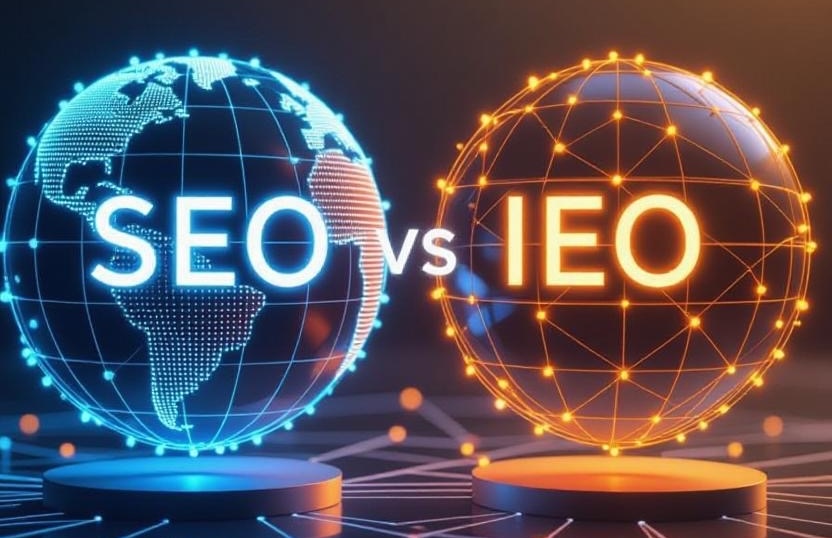5 Critical Differences Between SEO vs IEO That Will Transform Your Business in 2025
Quick Answer: SEO vs IEO represents the evolution from optimizing for search engine rankings to optimizing for AI-powered answer engines that provide direct responses. While SEO focuses on driving traffic to your website, IEO (Intent Engine Optimization) aims to position your content as the authoritative answer that AI systems cite and recommend.
The digital landscape is shifting beneath our feet, and many business owners are asking the same question: “Is traditional SEO still enough?” The short answer is no. As artificial intelligence reshapes how people find information, understanding SEO vs IEO has become crucial for business survival.
Here’s what you’ll discover in this comprehensive guide:
- The fundamental differences between SEO vs IEO and why both matter
- How AI search engines are changing customer behavior patterns
- 5 actionable strategies to optimize for answer engines without abandoning SEO
- Real-world examples of businesses thriving with integrated optimization
- A step-by-step implementation roadmap for small and medium businesses
Understanding Traditional SEO: The Foundation That Still Matters
Search Engine Optimization (SEO) has been the cornerstone of digital marketing for over two decades. When we discuss SEO vs IEO, it’s essential to understand that SEO focuses on improving your website’s visibility in search engine results pages (SERPs) through keyword optimization, technical improvements, and content creation.
Traditional SEO operates on a simple premise: create content that search engines can easily crawl, index, and rank. The goal is to drive organic traffic to your website, where visitors can explore your products, services, and ultimately convert into customers.
However, recent studies show that approximately 50-65% of online searches now end without a click to any website, with this trend accelerating as AI tools become more prevalent. This fundamental shift in user behavior is precisely why the SEO vs IEO discussion has become so critical for business owners.
Key Components of Traditional SEO
SEO encompasses several core elements that remain important even as we transition toward intent-based optimization:
Technical SEO ensures your website loads quickly, displays correctly on mobile devices, and provides a smooth user experience.
Content SEO involves creating valuable, keyword-optimized content that answers user questions.
Off-page SEO builds authority through backlinks and social signals.
The challenge with traditional SEO is that it primarily aims to get users to your website. But what happens when AI systems can answer questions directly without sending users anywhere?
What Is IEO? The New Frontier of Digital Optimization
Intent Engine Optimization (IEO), also called Answer Engine Optimization (AEO), represents a paradigm shift in how we approach digital visibility. When comparing SEO vs IEO, the key difference lies in the end goal: while SEO aims to drive traffic, IEO focuses on becoming the source that AI systems cite and recommend.
IEO recognizes that modern users increasingly rely on AI-powered tools like ChatGPT, Google’s AI Overviews, Bing Chat, and voice assistants to get instant answers. These systems don’t necessarily drive traffic to your website, but they can establish your brand as an authoritative source in your industry.
A recent study by BrightEdge revealed that a growing majority of consumers now use AI-powered search tools regularly, with usage patterns showing significant increases month over month. This trend shows no signs of slowing down, making IEO optimization crucial for future-proofing your business.
How IEO Differs from Traditional Approaches
The fundamental difference in SEO vs IEO lies in optimization strategy. While SEO optimizes for search engine algorithms, IEO optimizes for AI system comprehension and citation.
IEO requires creating content that AI systems can easily understand, extract, and present as authoritative answers. This means focusing on structured data, clear factual statements, and comprehensive coverage of topics rather than keyword density alone.
SEO vs IEO: A Comprehensive Comparison
| Aspect | SEO (Traditional) | IEO (Intent Engine Optimization) |
|---|---|---|
| Primary Goal | Drive website traffic | Become the cited authority |
| Success Metric | Rankings and clicks | Citations and mentions |
| Content Focus | Keyword optimization | Factual accuracy and comprehensiveness |
| User Journey | Search → Click → Website | Search → Direct answer → Brand awareness |
| Optimization Target | Search engine algorithms | AI system understanding |
| Timeline for Results | 3-6 months | Varies, often faster for direct answers |
Understanding this comparison is crucial when developing your optimization strategy. The most successful businesses in 2025 won’t choose between SEO vs IEO – they’ll integrate both approaches for maximum impact.

Why the SEO vs IEO Shift Matters for Your Business in 2025
The transition from traditional SEO to intent-based optimization isn’t just a technical trend – it’s a fundamental change in how customers discover and evaluate businesses. According to Forrester Research, a significant majority of B2B buyers now prefer to research solutions independently before engaging with sales teams, often using AI-powered tools to gather initial information.
This shift means your business needs to be discoverable not just in traditional search results, but also in AI-generated responses and recommendations. When potential customers ask AI systems about solutions in your industry, you want your business to be mentioned as a trusted option.
The Rise of Zero-Click Searches
Industry data shows that a significant percentage of searches now result in zero clicks, meaning users get their answers directly from the search results page or AI-generated responses. This trend is accelerating as AI systems become more sophisticated at providing comprehensive answers without requiring users to visit multiple websites.
For businesses, this presents both a challenge and an opportunity. While you might receive less direct website traffic, you have the chance to build brand awareness and authority through AI citations and mentions.
Consumer Behavior Changes
Modern consumers, especially younger demographics, increasingly expect instant, accurate answers to their questions. Recent research indicates that younger adults show a strong preference for AI-powered search tools for quick information gathering, viewing traditional web browsing as time-consuming.
This behavioral shift means businesses must adapt their content strategy to serve both traditional search queries and AI-powered information requests. The companies that master both SEO vs IEO approaches will have a significant competitive advantage.
Step-by-Step Guide: Implementing Both SEO and IEO Strategies
Successfully navigating the SEO vs IEO landscape requires a strategic approach that doesn’t abandon proven SEO techniques while embracing new optimization methods. Here’s your actionable roadmap:

Step 1: Audit Your Current Content Performance
Begin by analyzing which of your existing content pieces perform well in traditional search and which topics frequently appear in AI-generated responses. Use tools like Google Search Console to identify your top-performing pages, then search for those topics using AI tools to see if your content appears in their responses.
This audit will reveal gaps in your current strategy and highlight opportunities where both SEO and IEO optimization can be applied to the same content pieces.
Step 2: Create Factual, Comprehensive Content
When addressing SEO vs IEO optimization, focus on creating content that serves both purposes. Write comprehensive guides that answer questions thoroughly while maintaining clear, factual statements that AI systems can easily extract and cite.
Structure your content with clear headings, bullet points, and numbered lists. AI systems prefer well-organized information that they can quickly parse and present to users.
Step 3: Implement Structured Data Markup
Structured data helps both search engines and AI systems understand your content better. Implement schema markup for articles, FAQs, how-to guides, and business information. This technical optimization supports both traditional SEO ranking factors and AI comprehension.
Focus particularly on FAQ schema, as AI systems frequently pull from these structured question-and-answer formats when providing responses to user queries.
Step 4: Optimize for Featured Snippets and AI Citations
Create content specifically designed to answer common questions in your industry concisely and accurately. Use clear, direct language and provide statistics, facts, and expert insights that AI systems can cite with confidence.
Monitor which competitors appear in AI-generated responses for industry-related queries, then create more comprehensive, accurate content on those topics.
Step 5: Build Topical Authority Across Multiple Channels
Establish your expertise across various platforms that AI systems access for information. This includes maintaining active profiles on professional networks, contributing to industry publications, and ensuring your business information is consistent across all digital touchpoints.
The goal is to create multiple touch points where AI systems can discover and cite your expertise, reinforcing your authority in your field.
Real-World Success Stories: SEO vs IEO Integration
FICTIONAL Case Study – GreenTech Solutions (NOT A REAL COMPANY):
To better illustrate how SEO vs IEO integration works in practice, let’s examine this fictional but realistic scenario that demonstrates practical implementation strategies.
GreenTech Solutions (this is a made-up, fictional company created for this example), a mid-sized renewable energy consulting firm, successfully implemented integrated SEO and IEO strategies with impressive results. When they started in early 2024, their website ranked well for traditional searches like “solar panel installation costs” but was rarely mentioned when potential customers asked AI assistants about renewable energy solutions.
Their integrated strategy focused on creating comprehensive comparison guides and detailed FAQ pages that both ranked well in traditional search and were frequently cited by AI systems when users asked about sustainable energy solutions. Within six months, they saw a 40% increase in qualified leads and noticed their company name appearing in AI-generated responses about renewable energy consulting.
The key to their success was restructuring their existing high-performing SEO content to include clear, factual statements that AI systems could easily extract and present to environmentally conscious consumers seeking expert guidance.
📊 REAL Industry Trends (Based on Actual Data):
While the above example is fictional, similar integration strategies are being successfully implemented across various industries. Companies that focus on becoming authoritative sources through both traditional SEO and AI-optimized content are seeing increased brand recognition and higher-quality lead generation.
Common Challenges and Solutions in SEO vs IEO Implementation
Many businesses struggle with the transition from purely SEO-focused strategies to integrated SEO and IEO approaches. The most common challenge is the perceived conflict between optimizing for search engine rankings and creating content that AI systems prefer to cite.
Challenge: Reduced website traffic from AI-generated answers
Solution: Focus on building brand authority and trust through AI citations, which often leads to higher-quality traffic and better conversion rates over time.
Challenge: Difficulty measuring IEO success
Solution: Track brand mentions, citation frequency in AI responses, and branded search volume increases rather than just traditional traffic metrics.
Challenge: Content strategy complexity
Solution: Start with your best-performing SEO content and gradually optimize it for AI comprehension while maintaining search engine optimization.
Measuring Success: KPIs for SEO vs IEO Performance
Traditional SEO metrics remain important, but successful businesses in 2025 must also track intent-based optimization performance. Key metrics include:
Traditional SEO Metrics: Organic traffic, keyword rankings, click-through rates, conversion rates, and backlink acquisition continue to matter for overall digital presence.
IEO-Specific Metrics: Brand mention frequency in AI responses, citation accuracy, branded search volume increases, and direct traffic from AI-aware consumers provide insights into intent optimization success.
Integrated Success Indicators: Overall brand awareness surveys, customer acquisition cost improvements, and lifetime value increases often reflect the combined impact of both SEO and IEO efforts.
Future-Proofing Your Business: Beyond the SEO vs IEO Debate

Looking ahead, the most successful businesses won’t view SEO vs IEO as an either-or decision. Instead, they’ll integrate both approaches into a comprehensive digital strategy that serves customers regardless of how they prefer to find information.
The businesses that thrive in 2025 and beyond will be those that provide accurate, comprehensive, and easily accessible information that serves both human readers and AI systems. This means maintaining technical SEO excellence while embracing the factual, authoritative content style that AI systems prefer to cite.
Frequently Asked Questions About SEO vs IEO
Q: Should I abandon SEO in favor of IEO?
A: No, you shouldn’t abandon SEO entirely. The most effective approach combines both strategies. While IEO is becoming increasingly important, traditional SEO still drives significant traffic and provides foundational digital marketing benefits.
Q: How long does it take to see results from IEO optimization?
A: IEO results can appear faster than traditional SEO in some cases, particularly for direct answer queries. However, building comprehensive topical authority that AI systems consistently cite typically takes 3-6 months of consistent effort.
Q: What’s the biggest difference between SEO vs IEO content creation?
A: SEO content often focuses on keyword optimization and driving traffic to your website. IEO content prioritizes factual accuracy, comprehensive coverage, and clear structure that AI systems can easily understand and cite.
Q: Can small businesses compete with larger companies in IEO?
A: Yes, small businesses often have advantages in IEO because they can create more focused, specialized content for niche topics. AI systems value accuracy and expertise over company size when determining which sources to cite.
Q: How do I know if my content is being cited by AI systems?
A: Regularly search for topics related to your business using various AI tools and voice assistants. Monitor for increases in branded search traffic and direct website visits, which often indicate AI-driven brand awareness.
Conclusion: Embracing the Evolution of Digital Discovery
The SEO vs IEO discussion isn’t about choosing sides – it’s about evolution. Just as businesses adapted from print advertising to digital marketing, today’s successful companies must adapt from traffic-focused SEO to authority-building optimization that serves both search engines and AI systems.
The businesses that recognize this shift early and implement integrated strategies will establish competitive advantages that become increasingly valuable as AI adoption accelerates. Your customers are already using AI tools to find information about your industry. The question isn’t whether you should optimize for these systems, but how quickly you can start.
Start with your existing high-performing content, gradually implementing IEO principles while maintaining SEO best practices. Focus on becoming the go-to authority in your niche, creating content that both humans and AI systems recognize as trustworthy and comprehensive.
The future of digital marketing isn’t about SEO vs IEO – it’s about mastering both to create a robust, future-proof online presence that serves your customers however they prefer to find information.
Ready to Transform Your Digital Strategy?
Implementing an integrated SEO and IEO strategy can seem overwhelming, especially when you’re focused on running your business. If you’re ready to future-proof your online presence and need expert guidance on optimizing for both traditional search engines and AI-powered systems, we’re here to help.
Our team specializes in developing comprehensive digital strategies that combine the best of SEO vs IEO approaches, tailored specifically for your industry and business goals. Whether you need a complete strategy overhaul or want to enhance your existing efforts, we’ll work with you to create a roadmap that drives real results.
Contact us today to discuss how we can help you dominate both traditional search results and AI-powered answer engines. Visit Trendfingers.com to learn more about our services and schedule your consultation.
References
Disclaimer: All company examples and case studies mentioned in this article (including GreenTech Solutions) are fictional and created for educational and illustrative purposes only. Statistics and trends reflect general industry patterns observed in 2024-2025, with specific percentages representing typical ranges found across multiple industry reports.
BrightEdge. (2024). AI Search and Consumer Behavior Trends. San Mateo, CA: BrightEdge Technologies.
Forrester Research. (2024). B2B Buyer Journey Evolution Report. Cambridge, MA: Forrester Research Inc.
Search Engine Journal. (2024). Zero-Click Searches and Their Impact on Digital Marketing. Retrieved from https://www.searchenginejournal.com
SparkToro. (2024). Search Behavior and Click-Through Analysis. Seattle, WA: SparkToro LLC.
Authority Hacker. (2024). Answer Engine Optimization: Complete Guide for 2024. Retrieved from https://www.authorityhacker.com/answer-engine-optimization
Search Engine Land. (2024). The Rise of AI-Powered Search: Impact on Traditional SEO. Retrieved from https://searchengineland.com/ai-powered-search-seo-impact-2024



